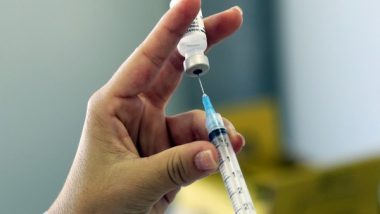San Francisco, January 3: Recent vaccination and boosters reduce infectiousness, but the risk of infection is still high, according to a study conducted in California prisons.
An examination by researchers at UC San Francisco that looked at transmission between people living in the same cell found that vaccination and boosting, especially when recent, helped to prevent the spread of COVID-19 in California prisons during the first Omicron wave. Also Read | COVID-19 Surge: One of Dominant Coronavirus Strains in China XBB Found in Pakistan.
The study indicates the advantages of vaccination and boosting in lowering the transmission, even in environments where many people are still becoming sick. Additionally, it demonstrates the cumulative effects of boosting and the additional protection that immunisation offers patients who have already contracted the disease. With each extra dose, the chance of transmission decreased by 11 per cent. Also Read | COVID-19: Second Booster Dose Not Required, Say Government Sources As India Records 134 Coronavirus Cases in Past 24 Hours.
"A lot of the benefits of vaccines to reduce infectiousness were from people who had received boosters and people who had been recently vaccinated," said Nathan Lo, MD, PhD, a faculty research fellow in the Division of HIV, Infectious Diseases and Global Medicine at UCSF and the senior author of the study in Nature Medicine. "Our findings are particularly relevant to improving health for the incarcerated population."
The researchers analyzed deidentified data collected by the California Department of Corrections and Rehabilitation (CDCR). This included COVID-19 test results, vaccine status and housing locations for 1,11,687 residents, 97 per cent of whom were male, between December 15, 2021, and May 20, 2022.
Breakthrough infections were common, despite the residents' relatively high vaccination rate of 81 per cent with the primary vaccine series. But the rate of serious illness was low. In just over five months, there were 22,334 confirmed SARS-CoV-2 Omicron infections, 31 hospitalizations and no COVID-19 deaths.
Vaccinated residents with breakthrough infections were significantly less likely to transmit them: 28 per cent versus 36 per cent for those who were unvaccinated. But the likelihood of transmission grew by 6 per cent for every five weeks that passed since someone's last vaccine shot.
Natural immunity from a prior infection also had a protective effect, and the risk of transmitting the virus was 23 per cent for someone with reinfection compared to 33 per cent for someone who had never been infected.
Those with hybrid immunity, from both infection and vaccination, were 40 per cent less likely to transmit the virus. Half of that protection came from the immunity that one acquires from fighting infection and the other half came from being vaccinated.
The researchers said they were gratified to see that vaccination confers additional protection even for those who had already been infected, but they were surprised by how much the infection continued to spread, despite the residents' relatively high vaccination rates.
"Regardless of the benefits you see in vaccination and prior infection, there is still a high amount of transmission in this study," said Sophia Tan, a researcher in Lo's lab and the study's first author. "We hope these findings can support ongoing efforts to protect this vulnerable population."
This includes making efforts to keep residents current with boosters and increasing the vaccination rate of the prison staff, only 73 per cent of whom had received the primary series at the time of the study.
The general rate of boosting could also be improved significantly. At the time of the study, just 59 per cent of residents and 41 per cent of staff had received all the doses recommended by the U.S. Centers for Disease Control and Prevention (CDC), based on their age and health status.
"Within the two months following vaccination, people are the least infectious, which indicates that boosters and large timed vaccination campaigns may have a role to reduce transmission in surges," Lo said. "New ideas are needed since the risk of infection in this vulnerable population remains so great."
(The above story is verified and authored by ANI staff, ANI is South Asia's leading multimedia news agency with over 100 bureaus in India, South Asia and across the globe. ANI brings the latest news on Politics and Current Affairs in India & around the World, Sports, Health, Fitness, Entertainment, & News. The views appearing in the above post do not reflect the opinions of LatestLY)













 Quickly
Quickly


